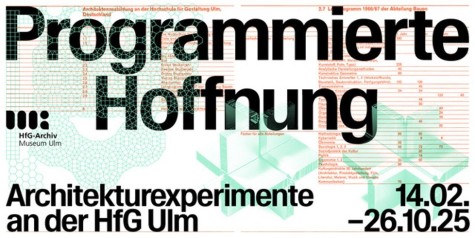Programmed Hope – Architectural Experiments at the HfG Ulm
February 15 to October 26, 2025
2025/02/21
Initially guided by founding rector and Bauhaus student Max Bill in the Bauhaus tradition, the architecture department of the HfG Ulm quickly evolved under Konrad Wachsmann and Herbert Ohl into a hub for “industrialized building.” Academically and internationally networked, faculty and students collaborated with the construction industry to develop visionary concepts for a technologized world. Alongside architects such as Richard Buckminster Fuller, Ray and Charles Eames, Frei Otto, and Yona Friedman, leading figures from the humanities, natural sciences, and engineering disciplines shaped the curriculum. Fields such as cybernetics, operations research, and the philosophy of science—represented by pioneers like Norbert Wiener, Max Bense, and Horst Rittel—became integral to the education. The goal was to conceptualize architecture as “programmed hope”—scientific, interdisciplinary, and socially responsible.
This approach inspired students to experiment, resulting in projects ranging from modular housing and school complexes to semi-automated shopping malls and serial space-frame constructions. Their work combined precise craftsmanship with advanced theoretical and technical expertise. Early algorithmic design methods, far ahead of their time, began to emerge.
The exhibition presents architectural models, original plans, drawings, and photographs—exclusively from the HfG Archive / Museum Ulm, many of which are being showcased for the first time.
Curated by Dr. Chris Dähne (Goethe University Frankfurt), Dr. Helge Svenshon (TU Darmstadt), and Dr. Martin Mäntele (HfG Archive / Museum Ulm). A richly illustrated accompanying volume will be published by av edition.
HfG Archive Ulm, Am Hochsträß 8, 89081 Ulm


